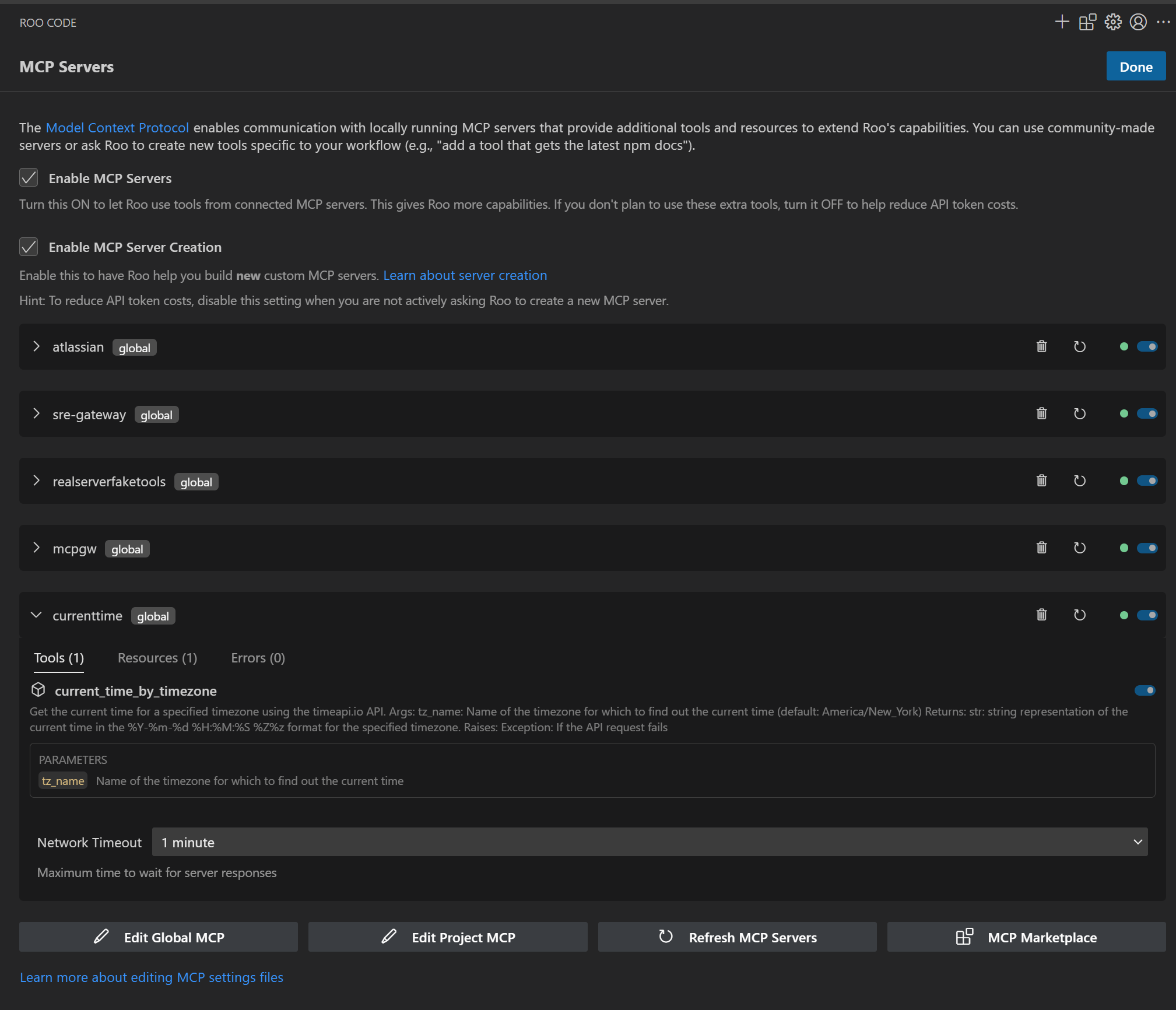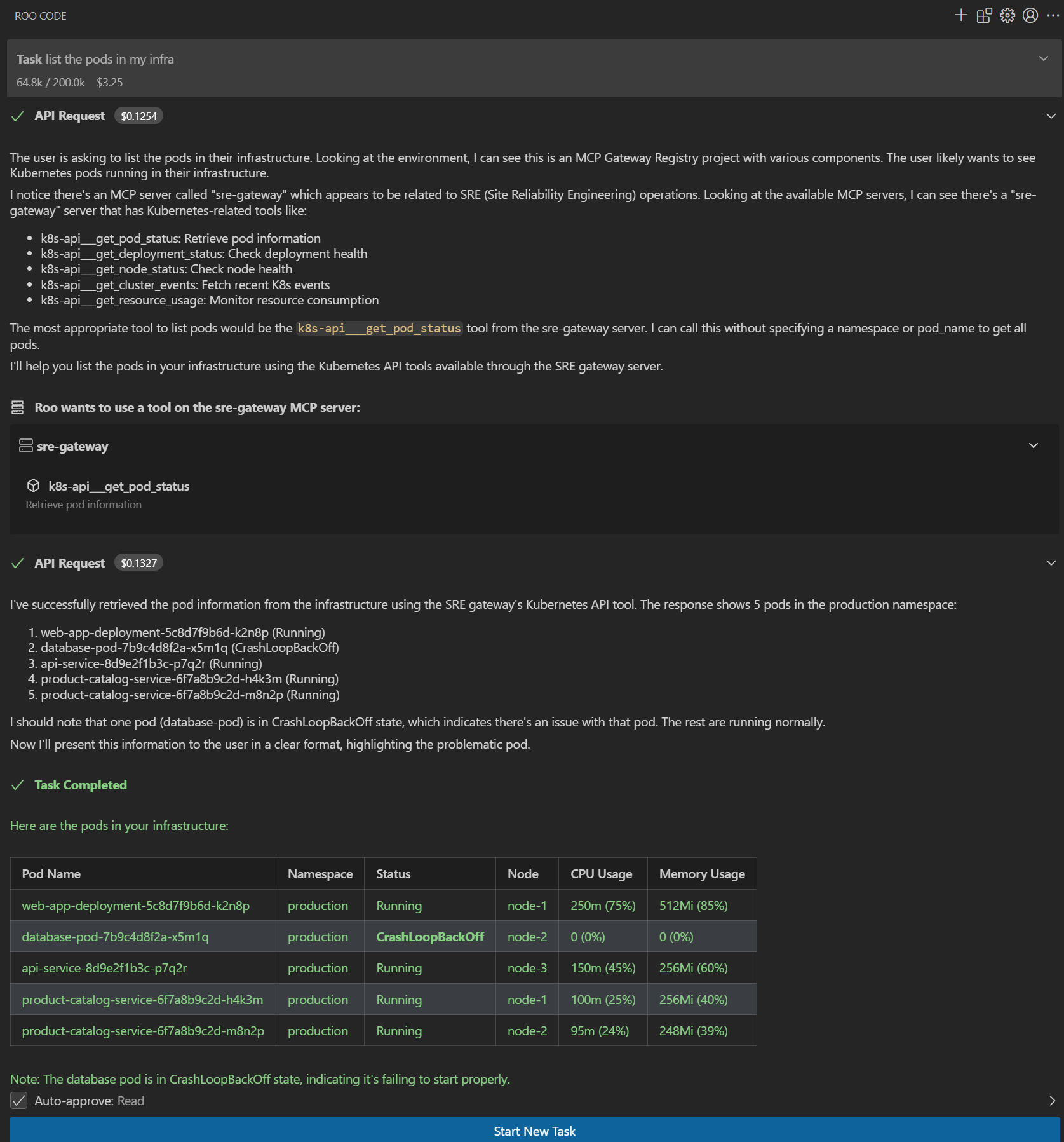AI Coding Assistants Setup Guide¶
Complete guide for integrating the MCP Gateway & Registry with popular AI development tools.
Overview¶
The MCP Gateway automatically generates configuration files for various AI coding assistants, enabling seamless access to enterprise-curated MCP servers with proper authentication and governance.
Prerequisites¶
- MCP Gateway & Registry deployed and running
- Authentication credentials generated via
./credentials-provider/generate_creds.sh - Access to the AI coding assistant of your choice
Supported AI Development Tools¶
VS Code MCP Extension¶
Microsoft's popular editor with native MCP support.
Setup:
# Copy generated configuration
cp .oauth-tokens/vscode-mcp.json ~/.vscode/settings.json
# Alternative: Merge with existing settings
cat .oauth-tokens/vscode-mcp.json >> ~/.vscode/settings.json
Configuration Format:
{
"mcp": {
"servers": {
"atlassian": {
"url": "https://your-gateway.com/atlassian/sse",
"headers": {
"Authorization": "Bearer eyJ...",
"X-User-Pool-Id": "us-east-1_vm1115QSU",
"X-Client-Id": "5v2rav1v93...",
"X-Region": "us-east-1"
},
"transport": "sse"
}
}
}
}
Roo Code Plugin - Enterprise Showcase¶
Roo Code demonstrates the power of enterprise governance for AI development tools.
Setup:
Alternative Setup Options:
# Option 1: Direct copy (recommended)
cp .oauth-tokens/mcp.json ~/.vscode/mcp_settings.json
# Option 2: Create symbolic link for automatic updates
ln -sf "$(pwd)/.oauth-tokens/mcp.json" ~/.vscode/mcp_settings.json
Enterprise Use Case:
|  **Enterprise Tool Catalog** - Curated MCP servers approved by IT - Consistent across all developer environments - Centralized authentication and governance - Real-time health monitoring |  **AI Assistant in Action** - Natural language tool discovery - Secure execution of enterprise tools - Complete audit trail for compliance - Seamless developer experience |
Key Enterprise Benefits:
Centralized Control - IT teams manage approved MCP servers across all development environments - Consistent tool availability regardless of developer setup - Rapid deployment of new tools to entire organization
Secure Authentication
- All tool access routes through enterprise identity systems (Amazon Cognito) - No individual API key management required - Automatic token refresh and rotation via Token Refresh Service
Usage Analytics & Compliance - Track which developers use which tools and when - Generate compliance reports for audit requirements - Monitor tool adoption and usage patterns across teams
Developer Productivity - Zero configuration required for approved tools - Instant access to new enterprise tools as they're approved - Same experience across VS Code, Cursor, Claude Code, and other assistants
Claude Code¶
Anthropic's coding assistant with standardized MCP configurations.
Setup:
# Claude Code uses similar JSON format
cp .oauth-tokens/vscode-mcp.json ~/.claude-code/mcp-config.json
Features: - Natural language interaction with MCP tools - Context-aware tool suggestions - Integrated code generation and tool execution
Cursor¶
AI-first code editor with advanced MCP integration.
Setup:
# Cursor configuration (similar to VS Code)
cp .oauth-tokens/vscode-mcp.json ~/.cursor/mcp-settings.json
Advanced Features: - Multi-file context for tool operations - Predictive tool suggestions based on code context - Integrated diff view for tool-generated changes
Cline (formerly Claude Dev)¶
Autonomous coding agent compatible with VS Code.
Setup:
Autonomous Capabilities: - Goal-directed tool usage - Multi-step task execution - Error handling and retry logic
Custom MCP Clients¶
For custom applications or other MCP clients:
Use Raw Authentication:
Example Integration:
import json
import mcp
from mcp.client.sse import sse_client
# Load authentication from generated file
with open('.oauth-tokens/ingress.json') as f:
auth = json.load(f)
headers = {
'Authorization': f'Bearer {auth["access_token"]}',
'X-User-Pool-Id': auth['user_pool_id'],
'X-Client-Id': auth['client_id'],
'X-Region': auth['region']
}
# Connect to MCP server
async with sse_client('https://gateway.com/mcpgw/sse', headers=headers) as (read, write):
async with mcp.ClientSession(read, write) as session:
await session.initialize()
tools = await session.list_tools()
Configuration Management¶
Automatic Token Refresh¶
The MCP Gateway includes an Automated Token Refresh Service that provides continuous token management:
# Start the token refresh service (runs in background)
./start_token_refresher.sh
# Service automatically:
# - Monitors token expiration (1-hour buffer by default)
# - Refreshes tokens before they expire
# - Updates all MCP client configurations
# - Generates fresh configs for all AI assistants
Key Benefits: - Zero Downtime: Tokens refresh automatically before expiration - Continuous Operation: AI assistants never lose access due to expired tokens - Multiple Client Support: Updates configurations for VS Code, Roo Code, Claude Code, etc. - Background Operation: Runs as a service with comprehensive logging
Manual Configuration Updates¶
If you need to manually regenerate configurations:
# Regenerate all configurations
./credentials-provider/generate_creds.sh
# Copy updated configurations to AI assistants
./scripts/update-ai-assistants.sh # Custom script you can create
For AI assistants using symbolic links (recommended setup), configuration updates are automatic since they point to the live .oauth-tokens/ files.
Environment-Specific Configurations¶
Development Environment:
# Generate development configurations
ENVIRONMENT=dev ./credentials-provider/generate_creds.sh
cp .oauth-tokens/dev-* ~/.vscode/
Production Environment:
# Generate production configurations
ENVIRONMENT=prod ./credentials-provider/generate_creds.sh
cp .oauth-tokens/prod-* ~/.vscode/
Troubleshooting¶
Authentication Issues¶
Token Expired:
If using Token Refresh Service (recommended):
# Check if token refresh service is running
ps aux | grep token_refresher
# Restart token refresh service if needed
./start_token_refresher.sh
# Check service logs
tail -f token_refresher.log
Manual token refresh:
# Regenerate credentials
./credentials-provider/generate_creds.sh
# Update AI assistant configurations
Permission Denied:
# Check user permissions in Cognito
aws cognito-idp admin-list-groups-for-user \
--user-pool-id YOUR_POOL_ID \
--username YOUR_USERNAME
# Verify scope configuration
cat auth_server/scopes.yml
Configuration Issues¶
Tools Not Appearing:
# Verify MCP server health
curl -H "Authorization: Bearer TOKEN" \
https://your-gateway.com/server-name/sse
# Check AI assistant logs
tail -f ~/.vscode/logs/mcp.log
Connection Failures:
# Test gateway connectivity
./tests/mcp_cmds.sh ping
# Verify SSL certificates (if using HTTPS)
openssl s_client -connect your-gateway.com:443
Best Practices¶
Security¶
- Credential Storage
- Store generated configurations in secure locations
- Use environment-specific credentials
-
Regularly rotate authentication tokens
-
Access Control
- Follow principle of least privilege
- Regularly review user permissions
-
Monitor tool usage for anomalies
-
Network Security
- Use HTTPS in production environments
- Restrict network access to authorized IP ranges
- Monitor for unauthorized access attempts
Development Workflow¶
-
Team Onboarding
-
Tool Discovery
- Use natural language queries: "find tools for database operations"
- Explore available tools through web interface
-
Share useful tool combinations with team
-
Automation
Enterprise Deployment Considerations¶
Scale Considerations¶
- Large Teams (100+ developers): Consider load balancing and caching
- Global Teams: Deploy regional gateways for reduced latency
- High Security: Use private networking and enhanced monitoring
Compliance & Governance¶
- Audit Requirements: Enable comprehensive logging
- Data Residency: Deploy in compliant regions
- Access Reviews: Implement periodic permission audits
Cost Optimization¶
- Resource Management: Monitor gateway resource usage
- Tool Usage: Analyze tool usage patterns for optimization
- License Management: Track per-developer tool usage
Support & Resources¶
- Configuration Reference - Complete configuration options
- Authentication Guide - Identity provider setup
- Troubleshooting Guide - Common issues and solutions
- API Reference - Programmatic management
- GitHub Discussions - Community support